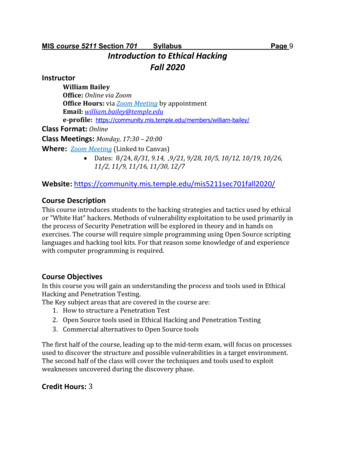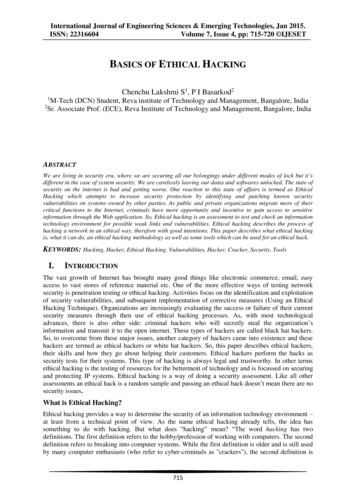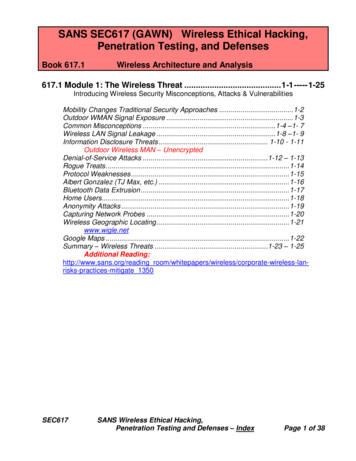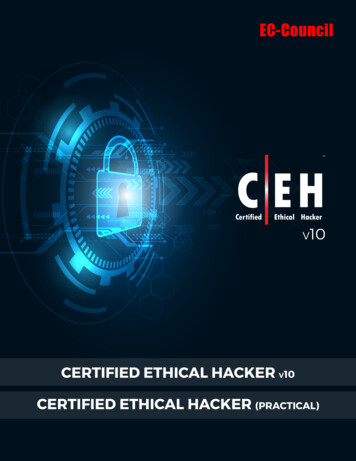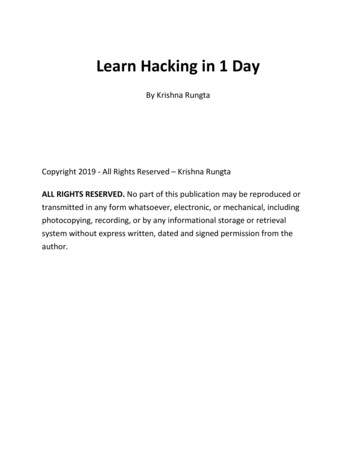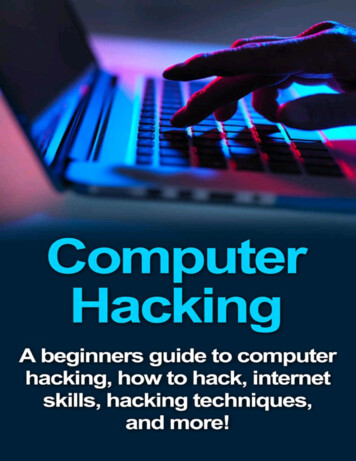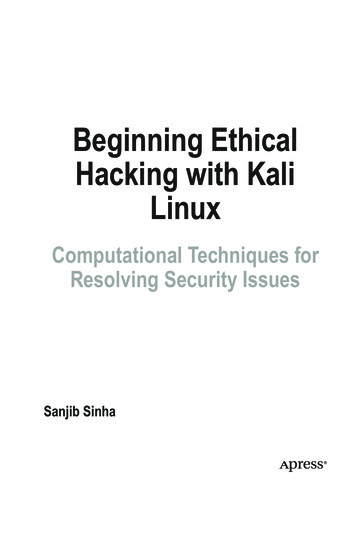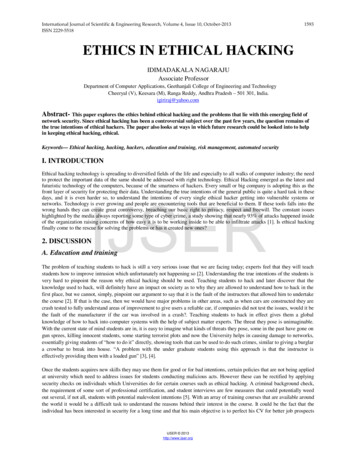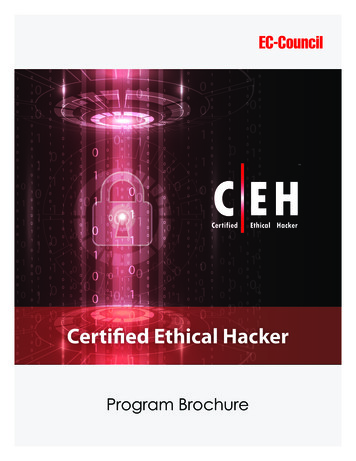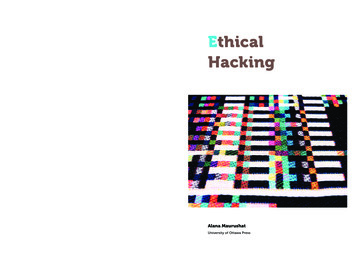
Transcription
EthicalHackingAlana MaurushatUniversity of Ottawa Press
ETHICAL HACKING
ETHICAL HACKINGAlana MaurushatUniversity of Ottawa Press2019
The University of Ottawa Press (UOP) is proud to be the oldest of the francophoneuniversity presses in Canada and the only bilingual university publisher in NorthAmerica. Since 1936, UOP has been “enriching intellectual and cultural discourse”by producing peer-reviewed and award-winning books in the humanities and socialsciences, in French or in English.Library and Archives Canada Cataloguing in PublicationTitle: Ethical hacking / Alana Maurushat.Names: Maurushat, Alana, author.Description: Includes bibliographical references.Identifiers: Canadiana (print) 20190087447 Canadiana (ebook) 2019008748X ISBN 9780776627915(softcover) ISBN 9780776627922 (PDF) ISBN 9780776627939 (EPUB) ISBN 9780776627946 (Kindle)Subjects: LCSH: Hacking—Moral and ethical aspects—Case studies. LCGFT:Case studies.Classification: LCC HV6773 .M38 2019 DDC 364.16/8—dc23Legal Deposit: First Quarter 2019Library and Archives Canada Alana Maurushat, 2019, under Creative Commons License Attribution—NonCommercial-ShareAlike 4.0 International (CC BY-NC-SA 4.0/Printed and bound in Canada by Gauvin PressCopy editingProofreadingTypesettingCover designCover imageRobbie McCawRobert FergusonCSÉdiscript enr. and Elizabeth SchwaigerFragmented Memory by Phillip David Stearns, n.d., PersonalData, Software, Jacquard Woven Cotton. Image Phillip DavidStearns, reproduced with kind permission from the artist.The University of Ottawa Press gratefully acknowledges the support extended toits publishing list by Canadian Heritage through the Canada Book Fund, by theCanada Council for the Arts, by the Ontario Arts Council, by the Federation forthe Humanities and Social Sciences through the Awards to Scholarly PublicationsProgram, and by the University of Ottawa.
Table of ContentsChapter I: Why Ethical Hacking? .11.11.21.3237You .Me .Ethical Hacking .Chapter II: Essential Terms and Concepts . 192.12.22.32.42.5Types of Ethical Hackers .Definitions and Typology of Ethical Hacking .Conventional Computer-Security-Threat Model .Common Methods Used in Ethical Hacking .Other Relevant Terms .1921222330Chapter III: Methodology and Quantitative Studies of EthicalHacking: Evidence-Based Decision and Policy-Making. 353.13.23.33.43.53.5.13.5.23.6Report for Public Safety Canada, 2011 .Summary of Findings .GDELT Analysis Service—Event Data(with Kevin Kim) .Google’s BigQuery (with Richard Li) .Dark-Net Analysis of Malware andCyber-Jihad Forums .Cyber-Jihad Forums (with Adrian Agius) .Hacking Forums (with Richard Li) .Observations .3538404345455055Chapter IV: Legal Cases Around the World(with Jelena Ardalic) . 57Chapter V: Select Ethical-Hacking Incidences: Anonymous. 97Chapter VI: Select Ethical-Hacking Incidences: Chaos ComputerClub, CyberBerkut, LulzSec, Iranian Cyber Army, and Others . 137
Chapter VII: Online Civil Disobedience . 1957.17.27.37.3.17.3.27.3.37.4Online Civil Disobedience in Context . 196Timeline . 200Case Studies . 201Anonymous, Operation Titstorm . 202German Lufthansa Protest . 205Twitter #TellVicEverything Campaign . 206Observations . 207Chapter VIII: Hacktivism . 2118.18.28.38.3.18.3.28.3.38.4Hacktivism in Context . 211Timelines . 212Case Studies . 216Anonymous, Post-Christmas Charity Donations . 216Neo-Nazi Website . 217WikiLeaks, Operation Payback . 217Observations . 219Chapter IX: Penetration/Intrusion Testing and VulnerabilityDisclosure . ration Testing and Vulnerability Disclosurein Context . 223Timeline . 225Case Studies . 227Australian Security Expert Patrick Webster . 227Cisco Router . 228LulzSec Hacking to Incentivize Sony to Fix KnownSoftware Bugs . 230Guardians of Peace, North Korea, and theSony Pictures Hack . 231Vulnerability Hunter Glenn Mangham . 231Da Jiang Innovation . 233Observations . 233Chapter X: Counterattack/Hackback . 23710.1 Counterattack/Hackback in Context . 23810.2 Case Studies . 24110.2.1 LulzSec, MasterCard and PayPal, and Barr. 242
10.2.210.2.310.310.4Illegal Streaming Link Sites . 243Automated Counter-DDoS . 244The Legalization of Hackback . 245Observations . 248Chapter XI: Security Activism . 25311.111.211.2.111.2.211.2.311.2.411.3Security Activism in Context . 253Case Studies . 254Spamhaus Project . 254Spam Fighter . 254Botnet Removal Communities . 256Cyber-Security Researcher Y . 258Observations . 259Chapter XII: Ethical-Hacking Challenges in Legal Frameworks,Investigation, Prosecution, and Sentencing . 26312.112.212.312.412.512.612.712.8Criminal Landscape: Convention on Cybercrime andthe Canadian Criminal Framework . 264Attribution . 267Jurisdiction . 269Evidence . 271Integrity, Volatility of Evidence, and theTrojan-Horse Defence . 272Damages . 274Sentencing and Dealing with Mental Disorders—Addiction and Autism Spectrum (with PhD candidateHannah Rappaport) . 274Observations . 279Chapter XIII: Ethical Hacking, Whistle-Blowing, andHuman Rights and Freedoms . 28713.113.213.3The Canadian Charter of Human Rightsand Freedoms. 288Whistle-Blowing and Ethical Hacking . 294Observations . 295
Chapter XIV: Toward an Ethical-Hacking Framework . 29914.114.214.314.414.514.614.7Ethical Hacking in Context . 299Encourage Legitimate Space for Virtual Protests . 301Guidelines and Policy . 302Code of Conduct for Hackback . 303Transparency of Government Engagementwith Hackback . 305Security Research Exemption andPublic-Interest Consideration . 305Concluding Remarks. 306Bibliography . 309Appendix: Interview Questions . 357
CHAPT ER IWhy Ethical Hacking?This book aims to explore the issue of ethical hacking from anunconventional and unique viewpoint, one that draws upon myown vast experience in this area. My background spans seventeenyears and has incorporated roles as a law and cyber-security professor, human-rights activist, cyber-policy consultant, technologydeveloper, and cybercrime investigation advisor. It is this experience that I will draw upon to form the pillars of the book, whichdeparts from some of the conventional thinking in this area. This isnot a book about Anonymous or about hacking organizations per se,though case studies from various incidences are certainly explored.This book is about various types of activities that are often referredto as “ethical hacking”—hacking for an ethical reason—whereby itwill be argued that law and policy ought not to be the same hereas for those hacking activities that are purely for economic gain orto cause harm or mischief. As will be seen, I have grouped ethicalhacking into five groups: online civil disobedience;hacktivism;penetration testing and security-vulnerability disclosure;counterattack/hackback; andsecurity activism.
2ETHICAL HACKINGLet us start this journey first by talking briefly about you, aboutme, and then a lot about ethical hacking.1.1 YouThe book is designed to cater to a broad spectrum of readers, rangingfrom cyber-security experts and policy-makers to academics. Despiteits intended primary audience, the book has also been written in sucha manner as to make it accessible not only to university students butthe broader general public. The complexity and rate of change seenwithin areas of technology, cyber security, and ethical hacking makeit essential not to assume that you are across all terminology. Thereare many terms that common media and blogs use incorrectly orinterchangeable, such as “computer virus,” which turns out to be a“computer worm.” Other new methods of malicious-software propagation may emerge that a reader would not necessarily be familiarwith. In general, ethical hacking involves many technical termsthat require a foundational level of understanding in order to betterunderstand policy and other issues. For example, a denial-of-serviceattack is potentially lawful if your own device is used to participatein an online political protest. It would not be lawful to use a botnetthat connects to unknown or third-party devices to participate inthe same protest. The aim is to provide you with digestible materialthat demonstrates concepts through engaging case studies. Thesecase studies of ethical hacking, spanning the last twenty years, aredissected and catalogued in a manner that identifies the groups andmovements, their motivations, and the techniques they used. Youwill see some of the most notorious of these incidences exploredreferenced in chapters 4–6, then selected incidences are looked incontext and by issues in chapters 7–13.If you are a policy-maker, chapters 3–7 and 14 are essentialreading. Chapter 3 provides the only publicly available quantitativeanalysis of ethical hacking in the world. The stark numbers containedwithin this chapter will assist you in demonstrating why the decisions and policies you recommend are fundamentally essential. As apolicy-maker, you are all too aware that in a world of cleverly maskedsensationalism posing as substantive information it has become difficult to discern what information can be trusted. Chapters 4–6 tablelegal cases and selected noteworthy incidences from the quantitative analysis. Throughout chapters 7–13 I aim to provide you with
Why Ethical Hacking?intricate and, at times, intimate looks at the world of ethical hacking,which will assist you in generating well-informed and robust policy.Chapter 14 discusses the required frameworks and changes requiredas a matter of both policy and law.If you are a cyber-security expert or consider yourself a hacktivist, there are ethical and legal issues contained within this bookthat are essential reading. This includes policy and legal lines to becautious of, which could easily see you cross from that of “ignoreaction with caution” to one of “prosecute” by authorities. Thesecautionary tales are drawn from my experience undertaking a largerange of roles, as described above.As I know all too well, the issues surrounding cyber securityhave garnered interest from a broad demographic of society, and isnot limited to just policy-makers, experts, and academics. Even ifyou do not fit within any of the three later categories, I would stilllove for you to drop me a line at alanacybersecurity.com and let meknow your background. While I keep analytics on how many peoplevisit the site, and the general geographic area of the IP addresses, thiswill give me an opportunity to engage with you and understand thebroader community interests. But please remember that if you arelooking at the site or wish to contact me about a private or sensitivematter, this site offers no anonymity to you. So, connect with a VPN,proxy or other anonymizer such as TOR.www.alanacybersecurity.comThere is also the option of communicating later using encryption and, for journalists, I have and use Signal.1.2 MeI have a confession: I am an ethical hacker. I use technology in anon-violent way in the pursuit of a cause, political or otherwise, which isoften legally and morally ambiguous. I don’t intentionally break the law.Many of the actions I take are assumed by politicians, lawmakers,and people around the globe to be legal because there are few to nolegal precedents and scant reportage. The law is written broadly,in a way that captures far more than one might expect. Part of mymotivation for writing this book is to highlight how desperately newlaw and policy are required for ethical hackers.3
4ETHICAL HACKINGAs a human-rights activist I work to educate and protect onlinecivil liberties globally, but more specifically for the jurisdictions inwhich I have lived and worked, namely Canada, Hong Kong, andAustralia. When I lived in Hong Kong I provided research assistancefor the OpenNet Initiative (a collaborative partnership betweenthe Citizen Lab at the University of Toronto, the Berkman Centerfor Internet & Society at Harvard Law School, and the AdvancedNetwork Research Group at the Cambridge Security Programme,Cambridge University) to examine how Chinese authorities filteredthe Internet in 2003–2005. The testing of which sites were blockedin the Chinese firewall meant that a host of domestic Chinese lawswere violated, even though the object was merely to provide anaccurate reflection of what types of sites were blocked, along withwhere, when, and possibly why these sites were filtered. I continueto be involved in research efforts addressing civil liberties andInternet freedom for the nongovernmental Freedom House, a libertywatchdog. I was the researcher and author of the Australian InternetFreedom portion of the annual Freedom House Report, Freedom onthe Net (2011–2017). Freedom on the Net is the most widely utilizedworldwide resource for activists, government officials, journalists,businesses, and international organizations aiming to understand theemerging threats and opportunities in the global Internet landscape,as well as policies and developments in individual countries.I am a professor and researcher above all else—I currently amthe Professor of Cybersecurity and Behaviour at Western SydneyUniversity. I am in the privileged position of leading multidisciplinary research and lecturing teams across a range of cyber-securityprojects and courses. I work with industry, government, and civilsociety on a daily basis. But my views about ethical hacking can betraced to a time and place long before I became a professor of cybersecurity. Here is a bit more about what informs the research, analysis,and opinions represented in this book.I was a key researcher with the law and policy division ofthe Data to Decisions Cooperative Research Centre (D2DCRC).The D2DCRC specializes in big data/artificial intelligence fornational-security purposes. The centre involved multiple computerscientists and data scientists from universities, industry (e.g., Palantirand SASS) along with governmental departments predominantlyin Australia but also in Canada and the United Kingdom. Withthe D2DCRC, we worked on confidential matters where we helped
Why Ethical Hacking?groups make informed decisions on how new technologies werebeing built and how they would function based on proposed newlegal and policy frameworks.From an international perspective, I was fortunate enough tobe asked to speak at a United Nations workshop in China on cybersecurity and human rights, where the majority of attendees werestudents and professors in the cyber-security division of the People’sLiberation Army’s National Defence University. The questions askedand views imparted to me were enlightening, and reminded me howmuch misinformation there is in cyber security and ethical hacking.My research from my honours in law, masters, and PhD degrees—andindeed my current research—has been entirely interdisciplinary, ashas my work with government, law firms, and later with universities.For my PhD I worked with underground security-activist groupsconcerned with botnets, conducted empirical qualitative research,and worked closely with the technical community to deepen theresearch. I worked with individuals and organizations in Europe,Asia, North America, and Australia. This included dialoguingand consulting with individuals from Internet-service providers,the Australian Communications and Media Authority, computeremergency response teams (in Australia, Canada, and Estonia),cyber-security journalists, Shadowserver, various computer-scienceresearchers, and the National Cyber-Forensic Training Alliance(an FBI and Carnegie Melon cybercrime training and investigativeservice, located in Pittsburgh). The thesis could best be describedas in the field of cyber security, using methods and analysis fromcriminology, economics, information systems, and the law. This bookborrows from my graduate work in botnets, especially in the chapteron security activism.I am on the board of directors and am the special cyber adviserfor the investigation firm IFW Global. IFW is an investigation firmspecializing in cybercrime and intelligence. My advisory workhas involved performing a variety of tasks, including surveillanceadvice, developing protocols for sensitive investigations in foreigncountries, providing legal information on investigative proceduresand contracting with intelligence units, as well as writing memoranda for arbitration disputes involving counterfeit engineeringproducts. Our investigations have involved online fraud and malicious online conduct, which has led us to cooperate with cybercrimeand anti-money laundering divisions of the FBI, CIA, Interpol, the5
6ETHICAL HACKINGAFP, the New South Wales Police Force, and Thai and Philippinespolice. Our investigatory work on one cybercrime case led to corruption investigations and charges against certain members of theQueensland police force. IFW is globally renowned for shuttingdown and recovering funds from sophisticated online organizedcrime, including payment-diversion fraud and boiler-room andbinary-option scams.Payment-diversion fraud typically involves a situation where anetwork and/or devices on a network are compromised, a criminalwatches the actions of the company over time and is able to divertpayment due to a supplier to an unknown third party. This is alsoknown as compromised supply-chain fraud.A boiler-room scam typically refers to a call centre sellingquestionable investments over the phone, and nearly almost alwayswith legitimate looking fake websites.Binary options involve a highly speculative form of trading where you don’t trade on a market but you often tradeagainst a binary-option “company” (in market parlance, a bucketshop)—effectively, an illegitimate broker. The binary-option brokerhas a backdoor into an online trading platform, where the brokercan manipulate prices while you, the potential customer, is trading—ensuring that you don’t win too often, or win just enough todraw you in to want to invest more. The chances of a payout areremote (one in several million), yet people are lured into investing due to premises of a big payout. Kind of like someone incitingyou to invest a large sum of money on a horse race with poor odds.The difference, however, is that the odds are so remote that thistype of investment is illegal in many jurisdictions. Additionally,the scammers are actively manipulating prices as you engage andinvest, luring you into losing more money. Communication is oftendone through highly encrypted apps such as Signal, and moneyis exchanged and funnelled through money-laundering processesand, increasingly, through cryptocurrencies. It is extremely difficultto recover money laundered through encrypted cryptocurrencies,making this type of online fraud a lucrative business.I provide legal and ethical information to computer-securityexperts (and almost certainly some hackers) on a wide range of topics, such as deviation of application program interfaces (APIs), datacrawling on the Deep Web, sale of vulnerabilities and bugs, copyrightissues in proof-of-concept videos, subverting national firewalls,
Why Ethical Hacking?disclosure of corrupt practices, and hacking targets. I do know thatrequests for information have come from Russia, Estonia, China,Jordan, Saudi Arabia, Australia, and Canada, but possibly too fromanywhere as people tend to use anonymizing technology to contactme to reduce risk of identification. One person goes so far as to onlysend me hard documents by post.Lastly, I have done consultancies for government and industry.In fact, this book is largely the product of research/consultancy workon ethical hacking for Public Safety Canada in 2010. Public SafetyCanada engages and works with various departments on a range ofcybersecurity issues and also houses the Canadian Cyber IncidentResponse Centre. As you can see, my understanding of cyber-securitybehaviour and ethical hacking is based on first-hand knowledge aswell as research. That’s more than enough about me; let’s move ontothe topic of the book: ethical hacking.1.3 Ethical HackingWhat is ethical hacking? My definition differs from the computerscience terminology (which only covers penetration/intrusion testingand vulnerability discovery), whereby I include online civil disobedience, hacktivism, penetration/intrusion testing and vulnerabilitydiscovery, counterattack/hackback, and security activism.Ethical hacking is the non-violent use of a technology in pursuit of a cause, political or otherwise, which is often legally andmorally ambiguous.This book examines five types of ethical hacking: online civildisobedience, hacktivism, penetration/intrusion testing and vulnerability discovery, counterattack/hackback, and security activism.I have briefly defined these below. Controversial aspects of my definitions are examined in chapter 2.Online civil disobedience is the use of any technology that connects to the Internet in pursuit of a political end. Civil disobedienceinvolves a just cause, where specific technology use is often legal.Hacktivism is a clever use of technology that involves unauthorized access to data or a computer system in pursuit of a cause orpolitical ends.1Penetration/intrusion testing is a type of information-systemssecurity testing on behalf of the system’s owners. This is knownin the computer-security world as ethical hacking. There is some7
8ETHICAL HACKINGargument, however, as to whether penetration testing must be donewith permission from a system’s owners or whether a benevolentintention suffices in the absence of permission. Whether permissionis obtained or not, however, does not change the common cause:improving security.Vulnerability discovery is the process of finding weaknesses andways in a network, device, or within the organization themselvesthat are capable of being exploited by others (sometimes for nefariousreasons). Vulnerability discovery is often done with the authorizationof the owner/operator of a network or device, but not always.Counterattack/hackback is also referred to as strikeback.Counterattack is when an individual or organization that is subject to an attack on their data, network, or computer takes similarmeasures to attack back at the “hacker/cracker” (see ch. 2 for definitions). For example, when an individual or organization is subject toa denial-of-service attack, that organization might initiate their owndenial-of-service attack on the responsible party’s website.Security activism is similar to penetration/intrusion testing inthat the cause is to improve security. Security activism goes beyondmere testing of security, however, to gather intelligence on crackersand to launch active attacks to disrupt criminal online enterprises.One example is the taking down of a botnet.There is no clear line between ethical hacking and vigilantism. Indeed, the water is murky, and what many might characterize as ethical others might see as a form of unwanted vigilantism.Vigilantism is understood to be outside of the state or beyond legal,or extra-state or extra-legal. Vigilantism may involve citizens acting in a manner they believe the state should permit yet currentlysanctions. Often a vigilante will break the law, often in responseto the state’s own violation of laws. There may be a sense that justice under due course will not occur, hence reaction to an action isrequired. Some might classify this as a valid or even ethical actionunder the circumstances, while others would paint the same actin a negative fashion, as vigilantism. Cyber vigilantism is similarto traditional forms of vigilantism. Traditional vigilantism mightinvolve the planning of an act, use or threat of force, reaction to acrime or other social act, and the notion of personal and collectivesecurity.2 Cyber vigilantes, as argued by Trottier, are individualswith computer-science skills who respond to cybercrime and cybersecurity.3 In this sense they might use an invasive “traceback” search,
Why Ethical Hacking?shut down a website, issue a distributed denial-of-service protest/attack, and hack into databases to expose corrupt practices. Or perhaps they take down botnets.But before we delve further into the world of botnets, cryptocurrency, Dark-Net forums, and hackers let’s begin with a tale of civildisobedience in 1960, with Martin Luther King Jr. and the civil rightsfight for equality and justice for African-American people. Fromthere we look at what some see as Julian Assange’s first escapade intohacktivism, with the use of the WANK worm to protest NASA’s useof nuclear fuel in rocket ships in the 1980s. You see, hacktivism isn’tas new as one might think, but it has and will continue to take newforms and be a prevalent form of protest and activism.Forcing the Line of Transparency 4Civil activists in the 1960s and 1970s had sit-ins and protests for civilrights and against war. Many people thought that civil disobediencewould lead to change. Change would lead to rational and criticaldiscussion of citizens with governments in a move toward moreopen and transparent democratic governance. In the late 1970s andearly 1980s, many governments enacted laws around freedom andaccess to informatio
not a book about Anonymous or about hacking organizations per se, though case studies from various incidences are certainly explored. This book is about various types of activities that are often referred to as “ethical hacking”—hacking for an ethical reason—whereby it will be

